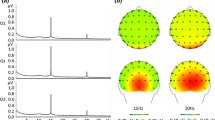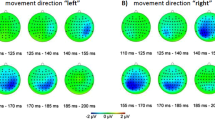Abstract
Manual reaction time (RT) and visual evoked potentials (VEP) were measured in motion onset and offset detection tasks. A considerable homology was observed between the temporal structure of RTs and VEP intervals, provided that the change in motion was detected as soon as the VEP signal has reached critical threshold amplitude. Both manual reactions and VEP rise in latency as the velocity of the onset or offset motion decreases and were well approximated by the same negative power function with the exponent close to −2/3. This indicates that motion processing is normalised by subtracting the initial motion vector from ongoing motion. A comparison of the motion onset VEP signals in two different conditions, in one of which the observer was instructed to abstain from the reaction and in the other to indicate as fast as possible the beginning of the motion, contained accurate information about the manual response.




Similar content being viewed by others
References
Allik, J., & Dzhafarov, E. N. (1984). Reaction time to motion onset: local dispersion model analysis. Vision Research, 24, 99–101.
Amano, K., Nishida, S., & Takeda, T. (2006). MEG responses correlated with the visual perception of velocity change. Vision Research, 46, 336–345.
Bachmann, T. (2000). Microgenetic approach to the conscious mind. Amsterdam: John Benjamins Publishing Company.
Bair, W., Cavanaugh, J. R., Smith, M. A, & Movshon, J. A. (2002). The timing of response onset and offset in macaque visual neurons. Journal of Neuroscience, 22, 3189–3205.
Bakardjian, H., Uchida, A., Endo, H., & Takeda, T. (2002). Magnetoencephalographic study of speed-dependent responses in apparent movement. Clinical Neurophysiology, 113, 1586–1597.
Ball, K., & Sekuler, R. (1980). Models of stimulus uncertainty in motion perception. Psychological Review, 87, 435–469.
Beauchamp, M. S., Cox, R. W., & DeYoe, E. A. (1997) Graded effects of spatial and featural attention on human area MT and associated motion processing areas. Journal of Neurophysiology, 78, 516–520.
Collewijn, H. (1972). Latency and gain of the rabbit’s optokinetic reactions to small movements. Brain Research, 36, 59–70.
Conover, W. J. (1980). Practical nonparametric statistics. NY: Wiley.
Culham, J., He, S., Dukelow, S., & Verstraten, F. A. (2001). Visual motion and the human brain: what has neuroimaging told us? Acta Psychologica, 101, 69–94.
Dzhafarov, E. N., & Allik, J. (1984). A general theory of motion detection. In M. Rauk (Ed.), Computational models of hearing and vision (pp. 77–84). Tallinn: Estonian Academy of Sciences.
Dzhafarov, E. N., Sekuler, R., & Allik, J. (1993). Detection of changes in speed and direction of motion: reaction time analysis. Perception and Psychophysics, 54, 733–750.
Gratton, G., & Coles, M. G. H. (1989). Generalization and evaluation of eye-movement correction procedures. Journal of Psychophysiology, 3, 14–16.
Gratton, G., Coles, M. G. H., & Donchin, E. (1983). A new method for off-line removal of ocular artifact. Electroencephalography and Clinical Neurophysiology, 55, 468–484.
Hohnsbein, J., & Mateeff, S. (1992). The relation between the velocity of visual motion and the reaction time to motion onset and offset. Vision Research, 32, 1789–1791.
Hohnsbein, J., & Mateeff, S. (1998). The time it takes to detect changes in speed and direction of visual motion. Vision Research, 38, 2569–2573.
Kaneoke, Y., Bundou, M., & Kakigi, R. (1998). Timing of motion representation in the human visual system. Brain Research, 790, 195–201.
Kawakami, O., Kaneoke, Y., Maruyama, K., Kakigi, R., Okada, T., Sadato, N., & Yonekura, Y. (2002). Visual detection of motion speed in humans: spatiotemporal analysis by fMRI and MEG. Human Brain Map**, 16, 104–118.
Kuba, M., & Kubová, Z. (1992). Visual evoked potentials specific for motion onset. Documenta Ophthalmologica, 80, 83–89.
Kuba, M., Kremláček, J., & Kubová, Z. (1998). Cognitive evoked potentials related to visual perception of motion in human subjects. Physiological Research, 47, 265–270.
Kubová, Z., Kremláček, J., Szanyi, J., Chlubnová, J., & Kuba, M. (2002). Visual event-related potentials to moving stimuli: normative data. Physiological Research, 51, 199–204.
Markwardt, F., Göpfert, E., & Müller, R. (1988). Influence of velocity, temporal frequency and initial phase position of grating patterns on motion VEP. Biomedica Biochimica Acta, 47, 753–760.
Maruyama, K., Kaneoke, Y., Watanabe, K., & Kakigi, R. (2002). Human cortical responses to coherent and incoherent motion as measured by magnetoencephalography. Neuroscience Research, 44, 195–205.
Mashhour, M. (1964). Psychophysical relations in the perception of velocity. Stockholm: Almquist & Wiksell.
Mateeff, S., Genova, B., & Hohnsbein, J. (1999). The simple reaction time to changes in direction of visual motion. Experimental Brain Research, 124, 391–394.
Mateeff, S., Dimitrov, G., Genova, B., Likova, L., Stefanova, M., & Hohnsbein, J. (2000). The discrimination of abrupt changes in speed and direction of visual motion. Vision Research, 40, 409–415.
Müller, R., Göpfert, E., Breuer, D., & Greenlee, M. W. (1999). Motion VEPs with simultaneous measurement of perceived velocity. Documenta Ophthalmologica, 97, 121–134.
Niedeggen, M., Sahraie, A., Hesselmann, G., Milders, M., & Blakemore, C. (2002). Is experimental motion blindness due to sensory suppression? An ERP approach. Cognitive Brain Research, 13, 241–247.
Patzwahl, D. R., & Zanker, J. M. (2000). Mechanisms of human motion perception: combining evidence from evoked potentials, behavioural performance and computational modeling. European Journal of Neuroscience, 12, 273–282.
Piéron, H. (1920). Nouvelles recherches su l’analyse du temps de latence sensorielle en fonction des intensités exitatrice. L’Année Psychologique, 22, 58–142.
Raymond, J. E. (2000). Attentional modulation of visual motion perception. Trends in Cognitive Sciences, 4, 42–50.
Schellart, N. A. M., Trindade, M. J. G., Reits, D., Verbunt, J. P. A., & Spekreijse, H. (2004). Temporal and spatial congruence of components of motion-onset evoked responses investigated by whole-head magno-electroencephalography. Vision Research, 44, 119–134.
Spekreijse, H., Dagnelie, G., Maier, J., & Regan, D. (1985). Flicker and movement constituents of the pattern reversal response. Vision Research, 25, 1297–1304.
Tynan, P. D., & Sekuler, R. (1982). Motion processing in peripheral vision: reaction time and perceived velocity. Vision Research, 22, 61–68.
Wang, L., Kaneoke, Y., & Kakigi, R. (2003). Spatiotemporal separability in the human cortical response to visual motion speed: a magnetoencephalography study. Neuroscience Research, 47, 109–116.
Whitney, D., Goltz, H. C., Thomas, C. G., Gati, J. S., Menon, R. S., & Goodale, M. A. (2003). Flexible retinotopy: motion-dependent position coding in the visual cortex. Science, 302, 878–881.
Acknowledgements
We thank Tiit Mogom for technical assistance and programming, Anne Must for running the experiments and Raili Põldsaar for language-correction of an early version of the manuscript. This study was supported by a grant from the Estonian Science Foundation (6244).
Author information
Authors and Affiliations
Corresponding author
Rights and permissions
About this article
Cite this article
Kreegipuu, K., Allik, J. Detection of motion onset and offset: reaction time and visual evoked potential analysis. Psychological Research 71, 703–708 (2007). https://doi.org/10.1007/s00426-006-0059-1
Received:
Accepted:
Published:
Issue Date:
DOI: https://doi.org/10.1007/s00426-006-0059-1




